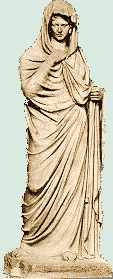
History of Roman costume
The Roman Empire is commonly reckoned from 53 B. C. to 500 A. D. During this long period Rome was the central influence on manners and customs of Europe, northern Africa and the eastern Mediterranean well into Asia. Most evidence for Roman, as well as Greek costume can be found from sculpture, wall-painting, mosaics, literature, jewellery and arms.

Costume in the Republican era (from its founding to about 100 BCE) was marked by its austerity and similarity to Greek dress. There were slight differences in garment construction: sleeves of the typical Greek chiton were formed from the top of adoubled rectangle; their Latin counterparts, the tunica and stola, usually opened at the sides for the armholes. Also, the Roman tunica habitually had medium-length draped sleeves.
The roots of Roman costume, particularly its most distinctive garment, the toga, come from the enigmatic Etruscans, whose costume also resembled Greeks, both European and Asiatic. Like the Greeks, Etruscans wore a cloak, the tebenna, a kind of plaid, sometimes rectangular and sometimes shaped like a segment of a circle. It was this garment that was the grandfather of Rome's most distinctive national dress: the toga.
Sources: History of Costume, Historic Costume for the Stage by Lucy Barton
VILLA > PERSONAL APPEARANCE
|
